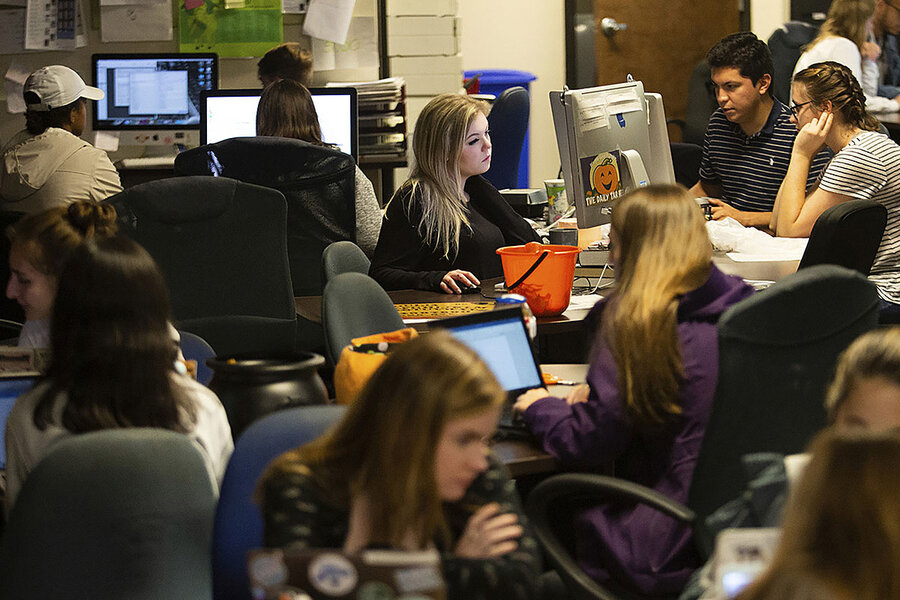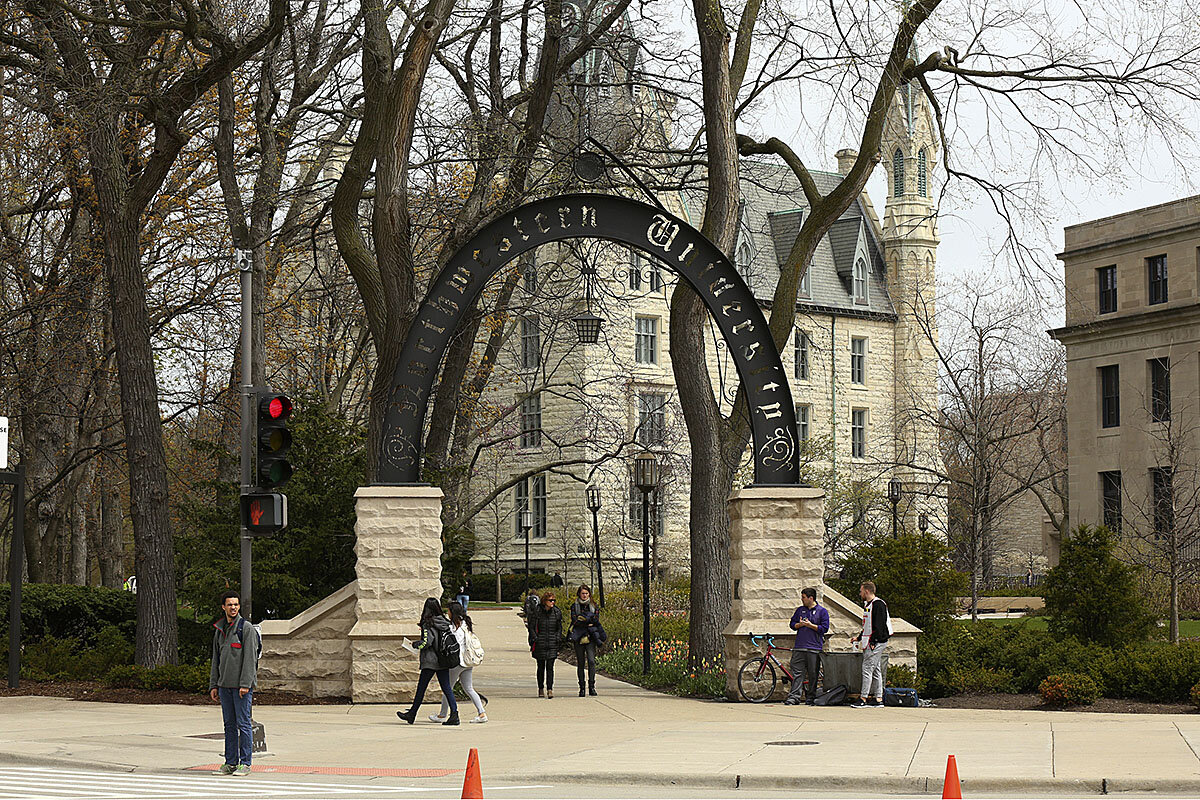Just the facts, but whose facts? College newspapers face student ire.
Loading...
| Cambridge, Mass.
At Harvard and other campuses the preference for information that supports already held beliefs is challenging press freedoms. More than 1,000 students signed a petition to boycott their student paper, The Crimson, for trying to present both sides of an immigration debate. After covering a campus “abolish ICE” rally, the paper requested comment from the agency – a decision some say put student activists at risk.
Entrenched viewpoints and increasing criticism of media outlets have converged on college campuses. Student journalists are weighing freedom of the press and the expectations of the communities they serve. If a person, group, or issue is perceived as a threat, does that disqualify the subject from media coverage? If readers think certain groups don’t deserve a voice, does listening to that group make journalists complicit?
“A lot of people … [think] students on campus today are snowflakes,” says Kathleen Bartzen Culver, a professor of journalism ethics. “I just don’t see it that way. I see this within that larger context of many, many people wanting journalism to be on their side. They want it to reinforce their worldview.”
Why We Wrote This
How do journalists protect a free press in an era when the job is misunderstood? That’s playing out on campuses, where listening to the other side is regarded by many as being complicit. It’s also one of the principles of journalistic fairness.
When Harvard freshman Ellie Hamilton thinks of U.S. Immigration and Customs Enforcement (ICE), she thinks of harsh, headline-grabbing immigration tactics – such as the family separation policy.
While the agency is often criticized for being overfunded and abusive in its own facilities, ICE is not, in fact, responsible for detaining children at the border (Customs and Border Protection is). Asked why she’d never heard of the agency’s other responsibilities – things like fighting drug trafficking and terrorism – Ms. Hamilton says she leans left, consumes like-minded news, and rarely seeks out the other side.
“There’s so much news out there that we kind of select the ones that just echo what our views are already,” she says. “So it’s kind of hard to even think that there are other views that are just so contrary to what I think.”
Why We Wrote This
How do journalists protect a free press in an era when the job is misunderstood? That’s playing out on campuses, where listening to the other side is regarded by many as being complicit. It’s also one of the principles of journalistic fairness.
At Harvard and other campuses, the preference for information that supports already held beliefs is challenging press freedoms. More than 1,000 students signed a petition to boycott their student paper, The Crimson, for trying to present both sides of an immigration debate. After covering a campus “abolish ICE” rally in September, the paper requested comment from the agency – a decision some say put student activists at risk.
Entrenched viewpoints and increasing criticism of media outlets have converged on college campuses. Student journalists are weighing freedom of the press and the expectations of the communities they serve. If a person, group, or issue is perceived as a threat, does that disqualify the subject from media coverage? If readers think certain groups don’t deserve a voice, does listening to that group make journalists complicit?
“A lot of people … [think] students on campus today are snowflakes,” says Kathleen Bartzen Culver, a professor of journalism ethics at the University of Wisconsin. “I just don’t see it that way,” she adds. “I see this within that larger context of many, many people wanting journalism to be on their side. They want it to reinforce their worldview.”
Certainly, student-run papers have been caught up in eras of turmoil dating back at least to the Vietnam War. And the widespread lack of understanding today about how reporters do their jobs extends well beyond college students. But the question of how best to balance learning their craft while extending empathy, particularly to marginalized groups, is one student journalists are grappling with at colleges and universities across the country. And it’s taking place at a time when campus newspapers, like the press broadly, are facing existential budget crises and institutional pressures from their own universities.
The campus newspaper at Northwestern University in Evanston, Illinois, faced blowback from students when reporters at the Daily Northwestern covered a Nov. 5 appearance of former Attorney General Jeff Sessions and protests of his visit. In that case, the student journalists apologized – sparking deep consternation among professional journalists who pointed out that covering a public event is one of the most fundamental tasks of reporting.
The criticism directed at campus newspapers at Northwestern and Harvard fits into a broader pattern of suppression of speech by students, particularly by those on the far left and right:
- On Oct. 23, students at the University of Pennsylvania shouted down Thomas Homan, a former acting director of ICE, ending his panel discussion on immigration policy before it could begin.
- At Boston University, about 200 students protested conservative pundit Ben Shapiro’s Nov. 13 lecture on campus. An online petition decrying his visit received more than 2,200 signatures.
- Members of a far-right group heckled Donald Trump Jr. off the stage during a Nov. 10 appearance at the University of California, Los Angeles, after he said he wouldn’t take questions.
The Northwestern case spotlights a challenge faced by student journalists today. Many of their peers consider certain opinions inherently harmful, which would prevent covering all sides of a story. Campus newspapers feel caught between the code of ethics of their craft or loyalty to a large portion of their student bodies.
Northwestern students censured the paper for its coverage of Mr. Sessions’ visit. When the paper published an apology letter promising “reform and reflection,” professional journalists criticized the Daily Northwestern for hypersensitivity. Charles Whitaker, dean of the Medill School of Journalism, issued a statement defending the student reporters, who he said were subject to “vicious bullying and badgering” for “the ‘sin’ of doing journalism.” The apology, however, “sends a chilling message about journalism and its role in society. It suggests that we are not independent authors of the community narrative, but are prone to bowing to the loudest and most influential voices in our orbit.”
Instead of apologizing, the Harvard Crimson doubled down on traditional ethics. In a note to readers, the paper’s editors defended their “belief that every party named in a story has a right to comment or contest criticism leveled against them.” Still, the petition continued adding signatures, and on Nov. 10, Harvard’s Undergraduate Council voted to “[stand] in solidarity” with the student group that started the boycott.
This kind of stonewall, experts say, is often worse for activists than it is for reporters – setting a dangerous precedent and distracting from protesters’ real message.
Mike Hiestand, senior legal counsel at the Student Press Law Center in Washington, D.C., asks students boycotting The Crimson to consider what reporters should do if they were to cover a new ICE policy. Should they request comment from pro-immigration groups?
“If [activists don’t provide comment] because they are somehow trying to punish The Crimson,” he says, “they’re really just punishing their own communities and their own efforts to try and have their voices heard.”
The example of ICE
The specific debate over ICE also shows that isolation can lead to misunderstanding.
October polling from Pew Research Center labeled ICE the only government agency with a higher unfavorable than favorable rating, at 54% to 42%. Experts say this animus toward ICE – not limited to college campuses – reveals wider frustration with U.S. immigration policy, which the agency has come to embody.
Part of what fuels this resentment, says Faiza Patel, co-director of the Brennan Center for Justice’s Liberty & National Security Program in New York, are two common misconceptions: All immigration enforcement is carried out by ICE, and ICE’s only role is immigration enforcement. The agency also limits cross-border criminal activity and terrorism. But Ms. Patel says its role in arrests and deportations – especially under the more “brutal” policies of the Trump administration – is more visible and thus a magnet for discontent.
“Being kind of the front-line agency that people see doing things,” she says, “[ICE] naturally is the focus of this unhappiness.”
Richard Rocha, a spokesman for ICE, says the agency doesn’t make the rules, it just enforces them. “One of the hardest things for ICE is that there are so many misconceptions about the work that we do,” he says, adding that their goal is to “make sure that the public is safe.”
ICE wants to address those misconceptions with the public directly, Mr. Rocha says, and stonewalling the agency does those willing to listen a “huge disservice.”
On Harvard’s campus
Harvard senior Cecilia Nuñez, president of the Phillips Brooks House Association, a community service group that signed The Crimson petition, says it’s important to stay informed, but students’ feelings of safety should take precedence. When it comes to The Crimson, she says she expects a more nuanced approach and “making sure that … getting both sides of a story doesn’t come with putting people at risk and putting people at danger.”
Other students, such as Harvard senior Gabe Fox-Peck, disagree. “The best arguments take into account the counterargument,” he says. “I don’t think that just speaking to an oppositional force, even if it’s dangerous, is a problem. I think that’s a good thing.”
For her part, Ms. Hamilton, the Harvard freshman, just wants a “middle ground.” Learning more about ICE didn’t end her disagreements with the agency, or U.S. immigration policy, but it did show her where those disagreements lay. She thinks a neutral news outlet – one that doesn’t just tell her what she wants to hear – would help remove those “blinders,” for her and the country.
“If people did tune into that,” she says, “then we wouldn’t have such polarized viewpoints.”
Staff writers Riley Robinson and Dwight Weingarten contributed to this report.








